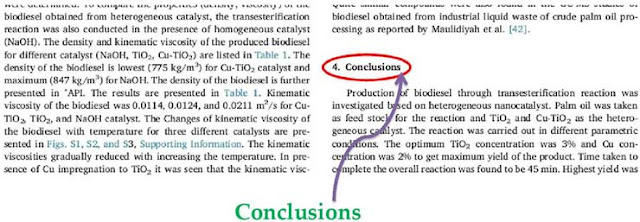Results and Discussion
Generally results and discussion are
written together in a research paper. Before start writing the results and
discussion section prepare all the figure, tables, and charts associated with
your research work. Here you have to mention about the output of your research work
in detail with proper explanation. If your research work is theoretical then
present it accordingly. During presenting your research output you must compare
this with previous research publications. If you got similar type of output as already
published that also have to be mentioned. Comparison of research outputs with
existing literature is a good way of presenting your work. There may be
subsection under results and discussion as I have shown in Figure 9.
If results and discussion section
contains any figures, tables or equations that must be presented in appropriate
format of the journal. How to present figure, table and equation in your
article that I have shown in Figure 10, 11 and 12 respectively for a particular
journal (here the journal name is Fuel) format. Each figure and table must
contain captions with appropriate number. Similarly equations should also contain
equation number. Depending on the order the figure number, table number,
equation number or chart number are decided. Each figure, table, chart or
equation must be referred within in the text in appropriate place.
 |
| Figure 9. A sample of a research paper showing results and discussion with its subsection. |
 |
| Figure 11. A sample of a research paper showing table, table caption and table number. |
 |
| Figure 12. A sample of a research paper showing equation and equation number. |
Conclusions
It is a
summary of your research output that you have already presented in materials
& methods and results & discussion section. Main points of the research
output must be included in the conclusions. Conclusions help the readers to
focus on the most importance point on your research paper. Mention the
significance of your research findings. Conclusions should also contain about
the specific application of your research output. Lastly you can share your
thought on your research output and indicate if there is any further research
scope in this area.
 |
| Figure 13. A sample of a research paper showing conclusions. |
Acknowledgments
Here
authors must acknowledge the funding agency who gave grant or fellowship in
implementing their project. Authors can also acknowledge individual people who
have helped in implementing the project to some extent but not justify
authorship. Acknowledgements should not contain section number.
 |
| Figure 14. A sample of a research paper showing acknowledgments in the paper. |
References
In this part of an article the references that have been cited in the text are listed. How many references should be cited that is not fixed, however 20 – 50 references are sufficient for a research paper. References should not contain section number. References may be placed alphabetical order by the surname of the first author followed by the initials of the author’s given name or it may be placed in the order as it is cited in the text. Figure 15 shown here representing references of an article which are placed according to the order as it is cited in the text. Figure 16 shown here presenting references of an article that are placed alphabetical order by the surname of the first author. Format of references is different for different journals. In Figure 17 I have shown three different formats of references from three different journals.
 |
| Figure 15. A sample of a research paper showing references. |
 |
| Figure 16. A sample of a research paper showing references. |
 |
| Figure 17. Samples of three different research paper from three different journals showing the different format of references. |
Supplementary information
If your research paper contains some additional data apart
from what you have presented in your article in that case you can include it in
the supplementary information. Supplementary information is also called as
supporting information. If there is supplementary information with your main article
then it must be referred in the text of your main article where ever it is
required. Figure 18 is showing a sample of supplementary information of a
research paper. Supplementary information generally includes details of the
experiments, graphs, charts, etc. In general there is guideline of journals to
prepare the supplementary information. Similar to the main manuscript the
supporting information also contain title page. That means it contains title of
the article, authors name, affiliations
of the authors and information about the corresponding author, etc.
 |
| Figure 18. A sample of a research paper showing supplementary information of the paper. |
The snapshots are taken from the following articles
1. De A, Boxi SS.Application of Cu impregnated TiO2 as aeterogeneousnanocatalyst for the production of biodiesel from palm oil. Fuel 2020; 265: 117019 (6pp).
2. Baskan MB, Pala A. A statistical experiment design approach for arsenic removal by coagulation process using aluminum sulfate. Desalination 2010; 254: 42 –48.
3. Boxi SS, Paria S. Visible light induced enhanced photocatalytic degradation of organic pollutants in aqueous media using Ag doped hollow TiO2 nanospheres. RSC Adv 2015; 5: 37657-37668.
4. Boxi SS, Mukherjee K, Paria S. Ag doped hollow TiO2 nanoparticles as an effective green fungicide against Fusariumsolani and Venturiainaequalis phytopathogens. Nanotechnol 2016; 27: 085103 (13pp).
5. Tsai C-Y, Hsi H-C, Kuo T-H, Chang Y-M, Liou J-H. Preparation of Cu-Doped TiO2 Photocatalyst with Thermal Plasma Torch for Low-Concentration Mercury Removal. Aerosol Air Quality Res 2013; 13: 639–648.
6. Wang Q, Jiang Z, Wang Y, Chen D, Yang D.Photocatalytic properties of porous C-doped TiO2 and Ag/C-doped TiO2nanomaterials by eggshell membrane templating. J Nanopart Res 2009; 11:375–384.

No comments:
Post a Comment